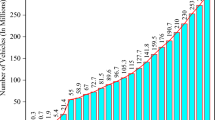Abstract
Noise exposure has been linked with numerous harmful health outcomes. The traffic volume is increasing rapidly in India. For environmentalists and town planner’s road traffic noise management always remains an exceedingly difficult job. It is important to monitor noise levels before taking any remedial measures. However, monitoring noise levels at different places is difficult. Using noise prediction models, we can solve this problem by predicting the noise levels at any location, but it is challenging to choose the model giving accurate predictions. So, while selecting a noise prediction model, validating any of the prediction models can give a better picture. The main aim of this study was to validate the noise prediction model Stop and Go using the observed data of road traffic in day and night. From the data analysis, it was established that the recorded ambient noise level in the research region exceeded the Central Pollution Control Board’s permitted standard of 45 decibels. The standard deviation between observed and predicted noise levels were found to be in the range of 0.24 to 2.17, indicating the model’s suitability and applicability in Indian traffic conditions. A t-test was also used to confirm the stop and go model’s validity and t statistical was found to be greater than t critical at a 5% level of significance.





Similar content being viewed by others
Data Availability
The data that support the findings of this study are available from the corresponding author, upon reasonable request.
References
Passchier-Vermeer W, Passchier WF (2000) Noise exposure and public health. Environ Health Perspect 108:123–131. https://doi.org/10.1289/ehp.00108s1123
Mishra RK, Parida M, Rangnekar S (2010) Evaluation and analysis of traffic noise along bus rapid transit system corridor. Int J Environ Sci Technol 7:737–750. https://doi.org/10.1007/BF03326183
Akhtar N, Ahmad K, Alam P (2016) Noise monitoring and map** for some pre-selected locations of New Delhi, India. Fluctuation Noise Lett 15. https://doi.org/10.1142/S021947751650019X
Alam P, Mazhar MA, Ahmad K et al (2022) Comparative assessment of road traffic noise through 2D noise map**: a case study of an urban area. Front Sustain 3. https://doi.org/10.3389/frsus.2022.1069445
Alam P, Ahmad K, Khan AH et al (2021) 2D and 3D map** of traffic induced noise near major roads passing through densely populated residential area of South Delhi, India. PLoS ONE 16:e0248939
Bunn F, Zannin PHT (2016) Assessment of railway noise in an urban setting. Appl Acoust 104:16–23. https://doi.org/10.1016/j.apacoust.2015.10.025
Agarwal S, Swami BL (2011) Comprehensive approach for the development of traffic noise prediction model for Jaipur city. Environ Monit Assess 172:113–120. https://doi.org/10.1007/s10661-010-1320-z
Kamineni A, Duda SK, Chowdary V, Prasad CSRK (2019) Modelling of noise pollution due to heterogeneous highway traffic in India. Transp Telecommunication 20:22–39. https://doi.org/10.2478/ttj-2019-0003
Ali SA, Tamura A (2002) Road traffic noise mitigation strategies in Greater Cairo, Egypt. Appl Acoust 63:1257–1265. https://doi.org/10.1016/S0003-682X(02)00046-4
Ouis D (2001) Annoyance from road traffic noise: a review. J Environ Psychol 21:101–120. https://doi.org/10.1006/jevp.2000.0187
Wang H, Luo P, Cai M (2018) Calculation of noise barrier insertion loss based on varied vehicle frequencies. Appl Sci (Switzerland) 8. https://doi.org/10.3390/app8010100
Alam P, Ahmad K, Akhtar N (2019) Temporal and spatial fluctuation of noise levels in the closed vicinity of urban roadways. Int J Recent Technol Eng 8:5983–5989. https://doi.org/10.35940/ijrte.C5914.098319
Alam P, Ahmad K, Akhtar N (2019) Temporal and spatial fluctuation of noise levels in the closed vicinity of urban roadways. Int J Recent Technol Eng 8:5983–5989. https://doi.org/10.35940/ijrte.C5914.098319
Pamanikabud BP, Tharasawatpipat C (1999) MODELING OF URBAN AREA STOP-AND-GO TRAFFIC NOISE. J Transp Eng 2:152–159
ISO 1996-1 I (2016) Acoustics — Description, measurement and assessment of environmental noise — Part-1
ISO 1996-2 I (2017) Acoustics — Description, measurement and assessment of environmental noise — Part 2
McClure CJW, Ware HE, Carlisle J et al (2013) An experimental investigation into the effects of traffic noise on distributions of birds: avoiding the phantom road. Proc Royal Soc B: Biol Sci 280. https://doi.org/10.1098/rspb.2013.2290
Alam MS, Corcoran L, King EA et al (2017) Modelling of intra-urban variability of prevailing ambient noise at different temporal resolution. Noise Mapp 4. https://doi.org/10.1515/noise-2017-0002
Hamidi M, Kavousi A, Zaheri S et al (2014) Assessment of the noise annoyance among subway train conductors in Tehran, Iran. Noise Health 16. https://doi.org/10.4103/1463-1741.134918
Rajakumara HN, Mahalinge Gowda RM (2009) Road traffic noise prediction model under interrupted traffic flow condition. Environ Model Assess 14:251–257. https://doi.org/10.1007/s10666-008-9138-6
Alam P, Ahmad K, Afsar SS, Akhtar N (2020) Validation of the Road Traffic noise prediction model RLS-90 in an urban area. Proc 3rd Int Conf Emerg Technol Comput Engineering: Mach Learn Internet Things ICETCE 2020 236–239. https://doi.org/10.1109/ICETCE48199.2020.9091759
Alam Pervez, Ahmad K, ASS (2021) and AN Validation of Road Traffic Noise Prediction Model CoRTN for Indian Road and Traffic Conditions. In: Malik Hasmat and Fatema N and AJA (ed) AI and Machine Learning Paradigms for Health Monitoring System: Intelligent Data Analytics. Springer Singapore, Singapore, pp 193–200
Funding
The authors declare that no funds, grants, or other support were received for conducting this study.
Author information
Authors and Affiliations
Corresponding authors
Ethics declarations
Conflict of interest
On behalf of all authors, the corresponding author states that there is no conflict of interest.
Additional information
Publisher’s Note
Springer Nature remains neutral with regard to jurisdictional claims in published maps and institutional affiliations.
Rights and permissions
Springer Nature or its licensor (e.g. a society or other partner) holds exclusive rights to this article under a publishing agreement with the author(s) or other rightsholder(s); author self-archiving of the accepted manuscript version of this article is solely governed by the terms of such publishing agreement and applicable law.
About this article
Cite this article
Alam, P., Mazhar, M.A. & Ahmad, K. Validation of Road Traffic Noise Prediction Model (Stop and Go) for Road Traffic Conditions of Delhi, India. Transp. in Dev. Econ. 10, 20 (2024). https://doi.org/10.1007/s40890-024-00208-y
Received:
Accepted:
Published:
DOI: https://doi.org/10.1007/s40890-024-00208-y




